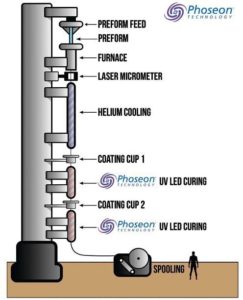Driving demand among global data centers hosting cloud infrastructure, television, high-speed Internet and wireless network providers, is the ability of optical fiber to transmit data over long distances with clarity and reliability. And manufacturers are selling fiber optic cable as fast as they can produce it. But building new manufacturing facilities takes time and money. The quickest and most economical way to increase production is to increase draw speed.
The Optical Fiber Drawing Process
Optical fiber is a fine glass wire the thickness of a human hair, surrounded by two layers of coatings that help with its properties and provide strength and protection.
The fiber is manufactured on draw towers, often several stories high, in which a preform, a large cylinder of optical glass, is melted and “drawn” down to a narrow diameter to create a continuous thread of glass. During the same process, the coatings are added to the glass fiber. Optical fibers are so thin that you can barely see them before the coatings are applied. The performing of precise, fool-proof, high-speed curing of the protective coatings is vital to the cable’s reliability.
“By switching to Phoseon’s UV LED technology, manufacturers have achieved up to a 50% increase in their draw speed. In addition to its speed advantage, UV LED curing reduces operational costs and energy usage by up to 70%.”
Using UV LED Curing Technology
Phoseon uses solid-state UV LED technology coupled with proprietary optics, rather than traditional UV arc or microwave lamps, to cure the primary and secondary coatings of the fiber. It is an exacting science. By switching to Phoseon’s UV LED technology, manufacturers have achieved up to a 50% increase in their draw speed. That increase in production is realized without the time and expense of adding new draw towers. And depending on the factory configuration, a Phoseon UV LED curing system can be installed in under 24 hours.
In addition to its speed advantage, UV LED curing reduces operational costs and energy usage by up to 70%. Also, UV LED light sources have a usable life of 20,000 to 30,000 hours, 10 times longer than arc lamps. Traditional curing systems also contain mercury not found in UV LED light sources, and produce ozone making for a less safe work environment.
Partners in the Industry
Phoseon is working closely with optical fiber manufacturers and coating suppliers, which it considers its partners in the industry, to tailor their formulations to the UV LED technology, so we can optimize results for all of us. It takes both a well-designed UV LED light source and coating material to realize the increased performance of the draw process.
Phoseon Technology is currently offering its fifth generation of optical fiber curing systems: the air-cooled [FireJet™] FJ228 and water-cooled [FirePower™]FP328, both of which consist of UV LED lamps, designed specifically for curing optical fiber, enclosed within an IP52 protective housing. Yet Phoseon does more than just provide the lamps, it also provides consultative engineering, installation and product support as well as works with the client to optimize the curing process.
Phoseon technology today has an upper irradiance— amount of light intensity created by the UV LED lamp that reaches the cure surface—250% higher than it had just three years ago, which equates to quicker curing and faster production speeds. Yet working with its industry partners does more than just help increase production. It also enables manufacturers to continue guaranteeing their cable for 20 years or longer.
Fiber optic cables are often placed in very harsh and hard-to-reach environments such as at the bottom of the ocean or in the ground. The last thing the manufacturers want is a product that fails a thousand miles out at sea. Working together, we are able to insure our customers provide a product that they are confident can stand behind their long warranty.
A Short Course in Optic Fibers
Fiber optics use thin flexible fibers of glass to transmit light signals for a variety of applications including telecommunications and medical applications. Fiber optic lines are strands of optically pure glass, often as thin as a human hair, that transmit high bandwidth digital information over long distances. The core optical fiber is covered with two coatings, with the inner coating designed to reflect the light back into the core and the outer “buffer” coating to protect the fiber from damage. Optical fibers are usually arranged in bundles of hundreds or thousands called optical cables.
Fiber optic cables offer several advantages in telecommunications. Compared with conventional copper wire, optical fibers are less expensive, thinner and lighter, more flexible, have a higher carrying capacity with less signal degradation and are immune to electromagnetic interference.
The medical industry uses fiber optics to provide lighting and medical imaging such as with bronchoscopes, endoscopes and laparoscopes. Other industries are also using fiber optics. Plumbers use fiber optics to inspect sewer lines and clogged drain pipes, carpenters use them to look inside walls and ceilings and mechanics use them to inspect engines and parts in tight/dark places.
UV LED Leap
Although optical fiber producers are making up-front investments in UV LED systems, in some cases they may have to change their processes to adapt to the new equipment. It has been our experience that they see a return on their investments rather quickly.
In addition to curing for optical fiber, Phoseon is also a major supplier of UV LED curing systems for near-instant curing of digital, screen, 3D and flexographic printing; industrial applications such as flat panel displays and automotive components; and a myriad of UV LED coating and adhesive applications. It has 270 patents and has shipped more than 90,000 units globally.
Tags: UV Filament Applications | UV LED Curing Systems for Fiber Optics | Wire & Cable Technology MagazineCategories: Coatings
